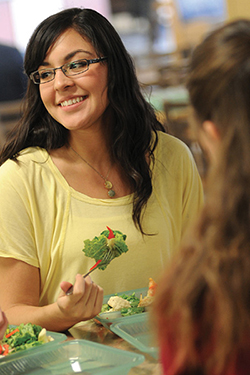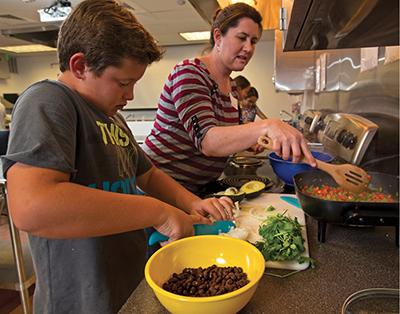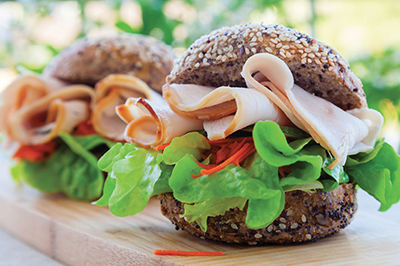Healthy Eating for Teens
Guide E-112
Revised by Raquel Garzon
College of Agricultural, Consumer and Environmental Sciences, New Mexico State University
Author: Extension Nutrition and Wellness Specialist, Department of Extension Family and Consumer Sciences, New Mexico State University. (Print Friendly PDF)
Nutritious food and eating healthy can help you:
- Feel good
- Enjoy friends and family
- Have energy for sports and activities
- Develop strength and endurance
- Show interest and enthusiasm
- Be focused and think clearly
- Manage your stress
Which of these benefits would be most important for you?
Healthy Eating Recommendations
Eat Breakfast Every Morning
Eating breakfast each morning gives your body and brain the energy needed to tackle all of the activities you have in your day. Are you in too much of a hurry for breakfast? It really doesn’t take long to have a bowl of cereal with milk and your favorite fruit. Don’t really feel like eating in the morning? Make yourself a fruit smoothie with ice, milk, and your favorite fruits. The options for an easy and healthy breakfast are countless! What are your ideas?
Eat the Lunch at School or Pack Your Own
The school lunch provides a balanced meal with food from each of the food groups. Check out the school menu to identify which days have the tastiest meals you want to eat. On days you aren’t in the mood for the school lunch, take a lunch from home. A peanut butter and jelly sandwich, fruit, a few cookies, and a container of cold milk can work. Not in the mood for a sandwich? You can take a tuna salad and eat it with crackers, and if you add some carrot or celery sticks and a yogurt, then you have a perfectly balanced meal. How about a tasty quesadilla with jicama sticks? Feel free to get as creative as you want! What are your ideas?

Choose Nutritious Snacks
Before you grab that next snack, stop and think about what you are going to get out of it—some snacks will give you a lot more nutrition than others. Instead of going for the typical chips, candy bar, or cookies, think about how you can maximize important nutrients by choosing something else. Fruits, such as apples, oranges, bananas, kiwi, and berries, are full of vitamins and minerals. Yogurt and milk drinks can provide you with protein and calcium. There are also granola and nutrition bars that have good amounts of fiber, protein, and important vitamins and minerals. Don’t forget about nuts and seeds that have good fats, protein, and fiber. There are even some vegetables that can make a tasty snack. What are your favorite healthy snacks?
Eat Dinner with Your Family
Eating dinner with your family is a chance to come together to discuss the events of the day and enjoy a meal together. Dinner is the perfect opportunity for a tasty, well-balanced meal. You can also get involved with dinner by helping with meal planning, shopping for groceries, cooking one of the dishes, setting the table, or cleaning up afterward. These activities help you to contribute to your family as well as prepare you for being on your own in the future. What are your ideas for a family dinner?

Drink Plenty of Water
Water is critical for the body and brain to function at their best. Be sure to drink water throughout the day, and drink more when you are more active or sweating. Water is a better choice than sodas or juices, which are filled with unnecessary sugar. You can make water more interesting to drink by flavoring it with cucumber slices or other pieces of natural fruits or vegetables. Stay hydrated!
Choosing Good Food
MyPlate (https://www.choosemyplate.gov) can help you make decisions about the foods you need to be healthy. See if you can find a way to create healthy meal ideas for breakfast, lunch, and dinner from the recommendations provided here.
Grains
Make about a quarter of your plate grain foods. Choose whole grains as often as possible. Whole-wheat bread, brown rice, oatmeal, whole-grain cereal, and whole-grain pasta are some examples.

© Zstockphotos | Dreamstime.com
Protein
Make about a quarter of your plate protein foods. Choose leaner protein sources if you can. Skinless chicken, lean beef or pork, fish, egg whites, beans, and nuts are a few examples.
Vegetables and Fruits
Make half of your plate vegetables and fruits. Go for ones that are dark green, red, and orange for higher levels of nutrients. Variety is important when it comes to maximizing nutrients, so get creative. Think of ways to incorporate vegetables each day. Here are just a few to think about: sweet potatoes, spinach, eggplant, carrots, broccoli, chile peppers, tomatoes, kale, asparagus, green beans, squash, celery, sweet peppers, and nopales. Fruits are even easier to eat throughout the day. Here are a few ideas: apples, oranges, plums, bananas, grapes, berries, melon, pineapple, pears, peaches, kiwi, mango, and cantaloupe.
Dairy
You should get one serving from the dairy group three times per day. Foods that count as dairy include milk, yogurt, soy milk, cheese, and cottage cheese. If you cannot or choose not to consume dairy products, then choose other foods high in calcium, such as calcium-fortified juice, calcium-fortified rice or almond milk, sardines, kale, bok choy, and tofu.
Listening to Your Body
One last recommendation is to practice listening to your body, specifically your stomach, to get to know the sensations you feel when you are hungry, satisfied, and full. Typically, when your body needs food, you will feel hunger. You might feel or hear your stomach growl or your stomach might feel empty. This is your body’s way of telling you that it needs food. When you feel hungry, you should eat. Eating regularly will prevent you from feeling extreme hunger or other symptoms of going too long without eating. When you do eat, you might stop eating when your stomach feels satisfied or when it feels just full. This is the right amount of food that will give you energy without causing you to feel sleepy, sluggish, or uncomfortable, which can happen if you feel overly full. Try to pay attention to how your stomach feels while eating and after you eat. When you practice doing this, you get better at eating when you are hungry and stopping when you are satisfied. This will ensure you feel your best!
Make the choice to eat healthy each day, so that you can bring your best energy to your daily activities, friends, and family!
Additional Resources
Beck, L. 2005. Healthy eating for preteens and teens: The ultimate eating guide to diet, nutrition, and food. Toronto: Penguin Canada.
Gold, R. 2009. Eat fresh food: Awesome recipes for teen chefs. New York: Bloomsbury USA.
U.S. Department of Health and Human Services, National Institute of Diabetes and Digestive and Kidney Diseases. 2016. Take charge of your health: A guide for teenagers [Online]. Available at https://www.niddk.nih.gov/health-information/health-topics/weight-control/take-charge-your-health/Pages/take-charge-your-health.aspx
For further reading
I-103: Physical Activity and Kids (School Age): Information for Parents
https://pubs.nmsu.edu/_i/I103/
I-104: Teens and Self-Cutting (Self-Harm): Information for Parents
https://pubs.nmsu.edu/_i/I104/
I-107: Suicide Prevention and Intervention in Schools
https://pubs.nmsu.edu/_i/I107/
I-110: Designer Drugs: Spice and Bath Salts
https://pubs.nmsu.edu/_i/I110/
Original authors: Mae Martha Johnson, Extension Food and Nutrition Specialist. Subsequently revised by Jane Hendley, Extension Food and Nutrition Specialist/EFNEP Coordinator; and Martha Archuleta, Extension Food and Nutrition Specialist.

Raquel Garzon is the Extension Nutrition and Wellness Specialist at NMSU. She has a doctorate in health science and is a Registered Dietitian. She has experience working as a clinical and community dietitian for adults and children, as well as working in the area of high-performance training for corporations and professional athletes. Her goal in Extension is to improve the well-being of New Mexicans through programs, collaborations, and education.
To find more resources for your business, home, or family, visit the College of Agricultural, Consumer and Environmental Sciences on the World Wide Web at pubs.nmsu.edu
Contents of publications may be freely reproduced for educational purposes. All other rights reserved. For permission to use publications for other purposes, contact pubs@nmsu.edu or the authors listed on the publication.
New Mexico State University is an equal opportunity/affirmative action employer and educator. NMSU and the U.S. Department of Agriculture cooperating.
Revised January 2018 Las Cruces, NM


